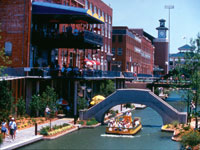 Oklahoma City OverviewOklahoma City, the state capital, quite literally sprang up out
of nowhere. On 2 March 1889, the US government held a major land
run in Oklahoma. The area, initially reserved as Indian Territory,
would be settled by those who were quick enough to grab plots when
the noon cannon fired. (Or by those who managed to creep across the
starting line beforehand, giving Oklahomans their current nickname,
Sooners.) Shortly afterwards, 10,000 people had staked claims
around a small train station, and the city was born. This boom-town
atmosphere continued when oil was discovered in Oklahoma City in
the 1920s. History buffs should plan a visit to the Oklahoma State
Capitol, the only one in America with a working oil well on its
grounds. Oklahoma City's growth has been a point of contention at times.
Today, it stretches across more than 600 square miles (965 square
km), one of the country's major perpetrators of urban sprawl. In
recent years, however, the city has been working to reinvent
itself, focusing on downtown revitalization with great success.
Most attractions of interest to tourists are located in the inner
city districts, beginning with Bricktown, which is bounded by one
of the country's premier minor-league ballparks, home of the
RedHawks. Once a clump of old warehouses, Bricktown is now a
vibrant collection of trendy condos, shops, restaurants, bars and
clubs situated along a picturesque canal. Here visitors can satisfy
their every craving for hardy American fare like steak and barbecue
ribs. Those in search of a more exotic meal should head to the Asia
District. Believe it or not, Oklahoma City has a significant
Vietnamese population, and a growing number of Asian residents of
other cultures. The Paseo Arts District, built in the 1920s, also
boasts a few upmarket cafés and cocktail lounges, though its
galleries and studios are the main draw. Modelled after a Spanish
village, its clay roofs and stucco walls house paintings, pottery,
stained glass works, jewellery and unique furniture. Culturally, Oklahoma City tends to be conservative. Visitors
hoping for the vibe and openness of coastal cities may be
disappointed, but the city's values do have a big bonus:
family-friendliness. Oklahoma City has plenty of fun attractions
for children and families. Its parks system is one of the most
extensive in the country, and its three nearby lakes are lovely
spots for camping, fishing and watersports. Stockyards City, right
downtown, is the largest stocker/feeder cattle market in the world,
where visitors can watch live auctions, shop for authentic Western
attire and sample stick-to-your-ribs food. Oklahoma City is known
as the 'Horse Show Capital of the World', and the city's many
equestrian events as well as its multiple museums make for
enjoyable family outings. Oklahoma has been said to inspire
nostalgia, and its capital city is no exception. Watching the
weekend regattas at Lake Hefner in the summer, and ice-skating in
the winter under Christmas lights at Bricktown's outdoor rink, are
memories families will not soon forget. |